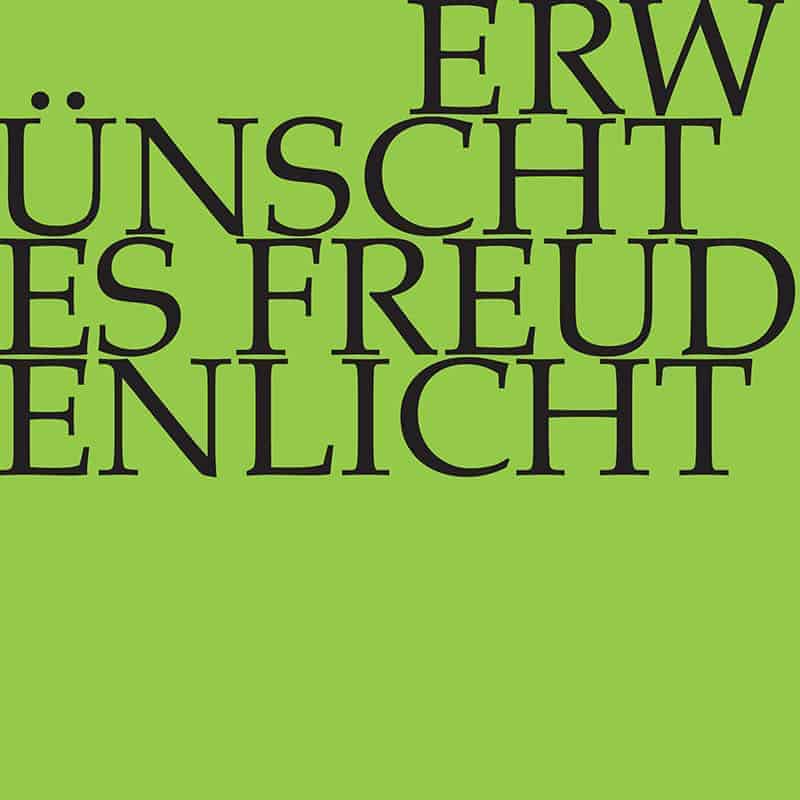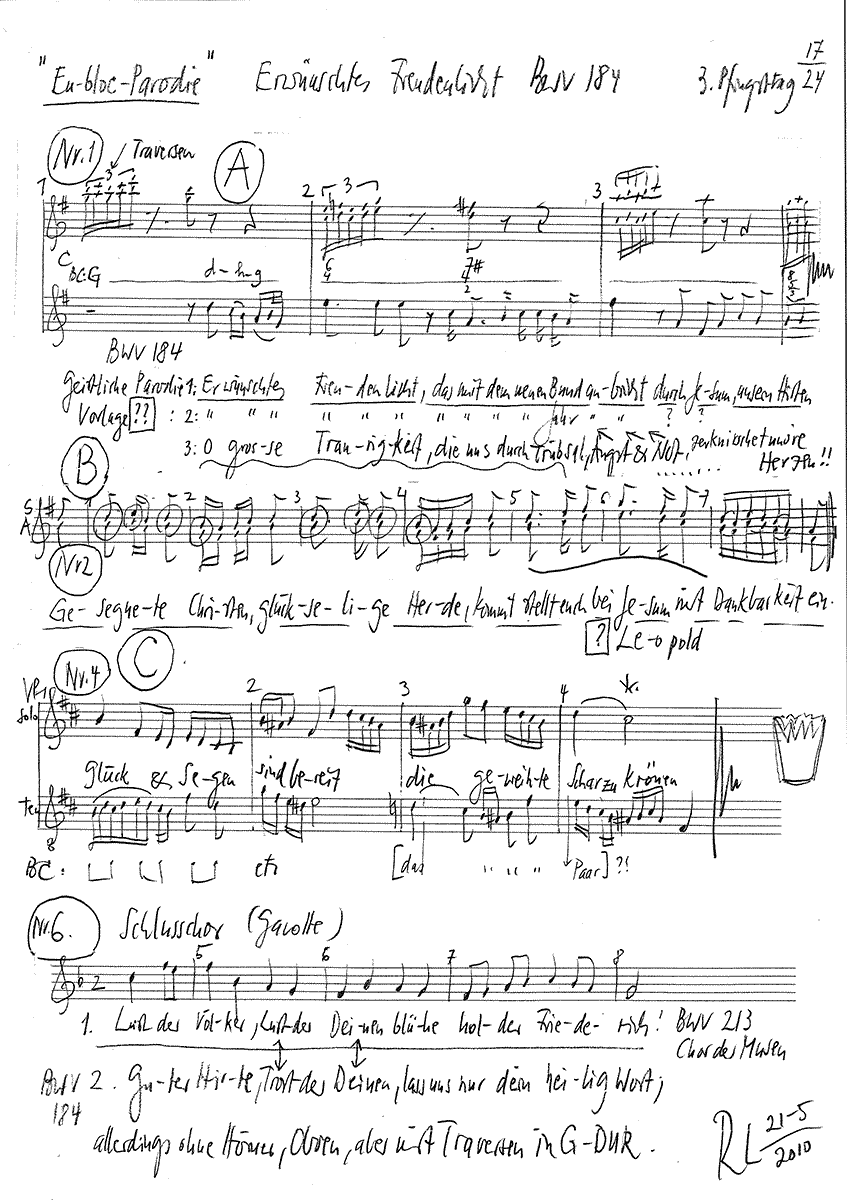Erwünschtes Freudenlicht
BWV 184 // For the Third Day of Pentecost
(O welcome light of joy) for soprano, alto, tenor and bass, transverse flute I+II, strings and continuo

Would you like to enjoy our videos ad-free? Subscribe to YouTube Premium now...
Workshop
Reflective lecture
Orchestra
Conductor & cembalo
Rudolf Lutz
Violin
Renate Steinmann, Plamena Nikitassova
Viola
Susanna Hefti
Violoncello
Martin Zeller
Violone
Iris Finkbeiner
Transverse flute
Claire Genewein, Maria Mittermayr
Musical director & conductor
Rudolf Lutz
Workshop
Participants
Karl Graf, Rudolf Lutz
Reflective lecture
Speaker
Alois M. Haas
Recording & editing
Recording date
05/21/2010
Recording location
Trogen
Sound engineer
Stefan Ritzenthaler
Director
Meinrad Keel
Production manager
Johannes Widmer
Production
GALLUS MEDIA AG, Switzerland
Producer
J.S. Bach Foundation of St. Gallen, Switzerland
Librettist
Text No. 1–4, 6
Poet unknown
Text No. 5
Anarg von Wildenfels, 1526
First performance
Third Day of Pentecost,
30 May 1724
In-depth analysis
While the chorale cantatas of Bach’s 1724/25 annual cycle were newly composed works based on a standard model, the Pentecost cantata BWV 184 harks back to a lost congratulatory cantata from Bach’s Cöthen period that was probably written with only two vocal parts. Bach reworked the cantata during his Leipzig period, performing it for a first time in 1724 and then at least once again in 1731, possibly undertaking further revisions.
With its cheerful transverse flute parts, the introductory tenor recitative exudes charm from the very outset. In keeping with the imagery of the good shepherd, the music evokes an early summer walk replete with cooing birds, making it rather difficult to focus on the earnest sermonising of the tireless “singing pastor”. Nonetheless, it is perhaps this internal tension that inspires the soloist to his enraptured arioso conclusion.
In line with its secular prototype, the soprano and alto duet combines amiable dance music with a full ensemble sound in typical courtly style. Complemented by sparkling instrumental figures, the duet in blissful thirds renews the image of an enchanted idyll, successfully presenting the somewhat dry theme of Pentecost in an uplifting light. In this setting, the singing is akin to an operatic love duo; indeed, in view of the delightful music, how the listener is supposed to reject the “Locken der schmeichelnden Erde” (attraction of worldly deceptions), as suggested in the middle section, remains the librettist’s well-guarded secret.
The second recitative, assigned once again to the tenor, expresses the insight that the souls chosen to reside in the heart of Jesus are blessed with a perfect joy that heralds the promise of heaven. In this setting, the text links imagery and figures from the Old Testament with Jesus’ sacrifice on the cross, thus lending the libretto a profundity akin to salvation history.
Amid this relaxed music-making, the following tenor aria with obbligato violin introduces an impassioned note of tension that makes the “güldne Zeit” (golden age) ushered in by Pentecost seem more a hard-won utopia than a luxurious paradise. In this movement, the prosody of the evidently new text is not always up to par, a matter that has been noted in various commentaries on the cantata.
While the chorale, a new setting of the eighth verse of the Reformation hymn “O Herre Gott, dein göttlich Wort” (O Lord God, your divine word) provides scope for a spirited arioso style, the closing chorus cannot hide its origins as a secular drama; here, in the outer sections, Bach evidently filled out the twovoice original to create a typical four-part choir setting. This lively movement was then reused in 1733 to the new text of “Lust der Völker, Lust der Deinen” (Joy of thy folk, joy of nations) in the Hercules cantata “Lasst uns sorgen, lasst uns wachen” (Let us tend him, let us watch him) composed in honour of Friedrich Christian, electoral prince of Saxony. It likely would also have found use in the introductory chorus to cantata V of the Christmas Oratorio had Bach not decided to compose the distinctly more rousing new setting of “Ehre sei dir, Gott, gesungen” (Glory to thee, God, be sounded).
Libretto
1. Rezitativ (Tenor)
Erwünschtes Freudenlicht,
das mit dem neuen Bund anbricht
durch Jesum, unsern Hirten!
Wir, die wir sonst in Todes Tälern irrten,
empfinden reichlich nun,
wie Gott zu uns den längst erwünschten Hirten sendet,
der unsre Seele speist
und unsern Gang durch Wort und Geist
zum rechten Wege wendet.
Wir, sein erwähltes Volk, empfinden seine Kraft;
in seiner Hand allein ist, was uns Labsal schafft,
was unser Herze kräftig stärket.
Er liebt uns, seine Herde,
die seinen Trost und Beistand merket.
Er ziehet sie vom Eitlen, von der Erde,
auf ihn zu schauen
und jederzeit auf seine Huld zu trauen.
O Hirte, so sich vor die Herde gibt,
der bis ins Grab und bis in Tod sie liebt!
Sein Arm kann denen Feinden wehren,
sein Sorgen kann uns Schafe geistlich nähren,
ja, kömmt die Zeit, durchs finstre Tal zu gehen,
so hilft und tröstet uns sein sanfter Stab.
Drum folgen wir mit Freuden bis ins Grab.
Auf! Eilt zu ihm, verklärt vor ihm zu stehen.
2. Arie (Duett Sopran, Alt)
Gesegnete Christen, glückselige Herde,
kommt, stellt euch bei Jesu mit Dankbarkeit ein!
Verachtet das Locken der schmeichlenden Erde,
daß euer Vergnügen vollkommen kann sein!
3. Rezitativ (Tenor)
So freuet euch, ihr auserwählten Seelen!
Die Freude gründet sich in Jesu Herz.
Dies Labsal kann kein Mensch erzählen.
Die Freude steigt auch unterwärts zu denen,
die in Sündenbanden lagen,
die hat der Held aus Juda schon zerschlagen.
Ein David steht uns bei.
Ein Heldenarm macht uns von Feinden frei.
Wenn Gott mit Kraft die Herde schützt,
wenn er im Zorn auf ihre Feinde blitzt,
wenn er den bittern Kreuzestod
vor sie nicht scheuet,
so trifft sie ferner keine Not,
so lebet sie in ihrem Gott erfreuet.
Hier schmecket sie die edle Weide
und hoffet dort vollkommne Himmelsfreude.
4. Arie (Tenor)
Glück und Segen sind bereit,
die geweihte Schar zu krönen.
Jesus bringt die güldne Zeit,
welche sich zu ihm gewöhnen.
5. Choral
Herr, ich hoff je, du werdest die
in keiner Not verlassen,
die dein Wort recht als treue Knecht
im Herzn und Glauben fassen;
gibst ihn’ bereit die Seligkeit
und läßt sie nicht verderben.
O Herr, durch dich bitt ich, laß mich
fröhlich und willig sterben.
6. Chor
Guter Hirte, Trost der Deinen,
laß uns nur dein heilig Wort!
Laß dein gnädig Antlitz scheinen,
bleibe unser Gott und Hort,
der durch allmachtsvolle Hände
unsern Gang zum Leben wende!



